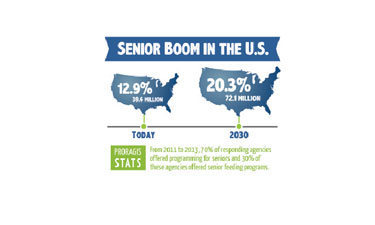 Seniors are going to take over your agency. Well, not quite — but you’re going to see more of them in your parks and facilities.
Seniors are going to take over your agency. Well, not quite — but you’re going to see more of them in your parks and facilities.
The 39.6 million seniors (those over age 65) in the United States currently comprise 12.9 percent of the population. By 2030, this number will swell to 72.1 million and more than 20 percent of the population — more than double the number of seniors in the U.S. in the year 2000. In fact, during the next 16 years, the proportion of seniors in the U.S. will surpass the number of kids under the age of 13. As discussed in an article by Dr. John Crompton in the December 2013 issue of Parks & Recreation Magazine, focusing on this senior demographic will impact the viability of park and recreation agencies in the near future, and forward-thinking agencies are already adjusting operations to better serve seniors.
Analysis of the data in PRORAGIS shows that the relationship between park and recreation agencies and seniors is already very strong. For each year between 2011 and 2013, 70 percent or more of agencies participating in PRORAGIS offer programs targeted at seniors. This indicates that for many seniors, their local park and recreation agency represents part of their day-to-day existence — whether to socialize, learn or engage in physical activity. However, for some seniors, the relationship with their park and recreation agency is even more important. PRORAGIS tells us that for the same period, more than 30 percent of these agencies offered programs that fed seniors in their communities, in some cases serving more than 25,000 meals annually.
Unfortunately, examination of population and economic projections indicate that efforts to fight senior hunger will be even more necessary in the coming years. New methods to examine poverty in seniors indicate that in at least 12 states the actual number of seniors living in poverty is more than twice previous estimates, with all 50 states underestimating senior poverty to some degree. Additionally, the disparity between the wealthiest and poorest seniors is growing rapidly. So while some seniors represent potential new revenue for park and recreation agencies due to their affluence, an increasing number of the poorest seniors will look to park and recreation agencies to facilitate necessary services due to their poverty.
What does this mean for your agency and your community? If you already support or provide a senior feeding program through your agency, it’s likely that your program may need to expand in the next 15 years. And, if your current offerings don’t include programs that support seniors living in poverty, it’s an area your agency may be called upon to address as the number of those in need increases.
Travis Smith, Ph.D., is NRPA’s Director of Research.

